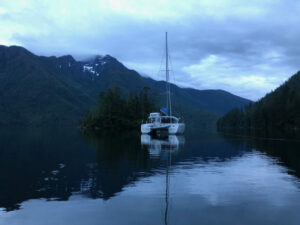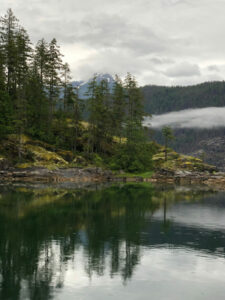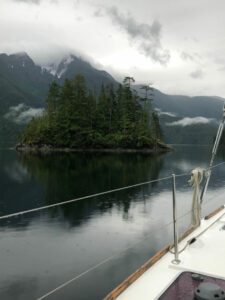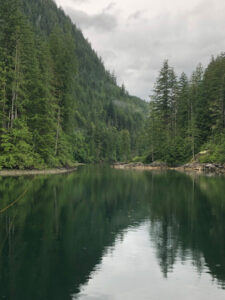As a valuable member of the crew on Chinook Sunset I have been fortunate to experience some of the natural beauty of the Pacific Northwest from the cockpit of our Lagoon 400. But occasionally there is a moment in time that becomes a special cherished memory exceeding any expectations that one could imagine. During one of our recent meanderings through Desolation Sound in June of 2020, I experienced such a moment. We had decided to anchor overnight at a tiny cove around East Redonda Island. The cove is just off Pendrell Sound and has been referenced as Lagoon Cove on some maps or Oyster Cove on others. It is an unobtrusive little cove, shaped somewhat like half a doughnut with a small islet, Shell Island, occupying the space where the hole would go and blocking southeast winds off the sound. A few boats might squeeze into this anchorage and a stern tie is absolutely necessary, but we were fortunate to be the only boat in this anchorage for our entire two-day stay.
This particular cove has an inner lagoon that is jealously guarded by razor sharp oyster shells acting as sentinels at the entrance. The generations of oysters that stand vigil have essentially created a reef over time that prevents the unwanted attention of a curious party in a dinghy, except at high tide.
The rainy weather had followed us from our previous location and we settled down to cook supper. I watched the black oystercatchers on the nearby shoreline with their comical crimson beaks while some of the crew went for a hasty paddle around the cove before the rain set in again. High tide wasn’t until late afternoon with a flood of 4.5 metres and my friend and shipmate, Linda and I decided to go for a paddle into the lagoon later that evening. She and her husband had tried earlier in the afternoon but could not get all the way through the entrance despite the low draft of our paddleboards.
As she and I began our paddle through the shallow channel, the wind died and the rain stopped. The oysters were now submerged enabling our paddleboards to quietly glide over them as we passed into the lagoon. The clouds lifted and the sun’s rays dappled through the old growth forest as we entered the lagoon. I inhaled the fresh, rich scent of ancient cedar wood and wet earth and felt at peace. An unspoken agreement between myself and my companion meant that we both fell into silence apart from an occasional excited whisper as we sensed the magic of our surroundings. The first wonder we came across was a stone totem; at high tide it was a circular island of rocks approximately a metre in diameter and two metres tall. A small, chunky stone figure stood proudly at the top and pointed into the distance toward some mystery yet to be discovered.
As we paddled along the southwestern shore, the quiet bubbling of a waterfall could be heard in the distance. Suddenly, we heard some rustling and groaning along the shoreline. I thought that at any moment a deer or bear would appear along the water’s edge. Alas, upon further investigation we discovered an old pipe gushing irregular spurts of water high up along the hill. Quietly laughing at our foolishness, we continued to paddle toward the far end of the lagoon.
A mist had settled over a bed of sea asparagus along the far shore, but the sun broke through to display rippling sparkles dancing upon the water. The only sounds were our paddles gently dipping into the water and the muted, relaxed chirps of various songbirds as if they too didn’t want to disturb the peacefulness of the lagoon. I enjoyed the moment and then turned my attention toward the northwest shore. I stood in awe at the revelation before me.
I was speechless as my companion excitedly whispered, “Look Judy! It’s a ship!” This was no ordinary ship. There were four wooden pontoons made from old cedar logs, each shaped to a pointed “S” at the bow to cut through the waves that she once sailed. The chainplates were rusted and of the same dark brown waterlogged colour as the cedar pontoons. It’s difficult to say how long the ship had been entrapped in the lagoon. But it was long enough for nature to create a masterpiece, for she had lovingly encased the ship in her own material. The towering mast was now formed by old growth trees, one of which had toppled and dipped toward the water. What once was the standing rigging and shrouds was now delicately traced by vines and moss. As nature spun her masterpiece, the ship became shrouded and disguised as part of the shoreline, virtually invisible from the entrance.
As the light started to fade, we completed our circuit around the remainder of the lagoon. Water totems lay proudly along the shoreline; perfect mirror images reflected in the still water, forming interesting symmetrical patterns, perhaps an inspirational muse for some ancient artist. But my thoughts kept returning to the joyful discovery of the ship. Who built the ship and where were they now? How old was the ship and how was it swept into the lagoon? How long did it take for nature to claim the ship as her own? My imagination further pondered additional embellishments nature might add to her masterpiece over time. I mused that generations of spiders might weave new silken sails allowing a gentle breeze at high tide to set the ship free from the lagoon once more.
It’s said that a picture is worth a thousand words. However, the joy of discovery that becomes forever embedded in one’s memory is worth a thousand pictures. I leave this special moment of wonder and magic to the next curious explorer to discover at high tide.
Photo 1 Chinook Sunset on anchor at Oyster Cove
Photo 2 Shoreline upon arrival
Photo 3 Shell Islet
Photo 4 Lagoon entrance at high tide




